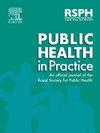Mobile health clinics for distribution of vaccinations to underserved communities during health emergencies: A COVID-19 case study
IF 2.2
Q2 PUBLIC, ENVIRONMENTAL & OCCUPATIONAL HEALTH
引用次数: 0
Abstract
Objectives
Mobile health clinics (MHCs) effectively provide healthcare to underserved communities. However, their application during health emergencies is understudied. We described the implementation of an MHC program delivering vaccinations during the COVID-19 pandemic, examined the program's reach to medically underserved communities, and investigated characteristics of vaccination uptake in order to inform the utility of MHCs during health emergencies.
Study design
The study observed COVID-19 MHC vaccination rates and factors associated with uptake between February 20th, 2021, and February 17th, 2022.
Methods
Prisma Health deployed six MHCs to underserved communities. We described the characteristics of individuals who utilized the MHCs and evaluated census tract-level community factors associated with use of the MHCs through generalized linear mixed effects models.
Results
The MHCs conducted 260 visits at 149 unique sites in South Carolina, providing 12,102 vaccine doses to 8545 individuals: 2890 received a partial dose, 4355 received a primary series, and 1300 received a booster dose. Among individuals utilizing the MHC, the median age was 42 years (IQR: 22–58), 44.0 % were Black, 49.2 % were male, and 44.2 % were uninsured. Black, Hispanic, and uninsured individuals were significantly more likely to utilize MHC services for COVID-19 vaccination. During periods when vaccines were limited, MHC utilization was significantly greater in communities facing access barriers to healthcare.
Conclusions
The high COVID-19 vaccination uptake at MHCs demonstrated that the MHC framework is an effective and acceptable intervention among medically underserved populations during health emergencies, especially when resources are scarce. The identified factors associated with vaccination uptake demonstrated that the MHCs had the greatest impact in higher-risk communities and can be used to inform allocation of such field-level interventions in future health emergencies.
在卫生紧急情况下为服务不足的社区分发疫苗的流动医疗诊所:COVID-19 案例研究
目标移动医疗诊所(MHC)能有效地为服务不足的社区提供医疗保健服务。然而,人们对其在卫生紧急情况下的应用研究不足。我们介绍了在 COVID-19 大流行期间提供疫苗接种的移动医疗诊所计划的实施情况,检查了该计划对医疗服务不足社区的覆盖情况,并调查了疫苗接种率的特征,以便为移动医疗诊所在卫生紧急情况下的应用提供参考。研究设计该研究观察了 2021 年 2 月 20 日至 2022 年 2 月 17 日期间 COVID-19 移动医疗诊所的疫苗接种率以及与接种率相关的因素。方法Prisma Health 在医疗服务不足的社区部署了六个移动医疗诊所。我们描述了使用 MHC 的个人特征,并通过广义线性混合效应模型评估了与使用 MHC 相关的人口普查区级社区因素。结果MHC 在南卡罗来纳州的 149 个独特地点进行了 260 次访问,为 8545 人提供了 12102 剂疫苗:2890 人接种了部分剂量,4355 人接种了初级系列,1300 人接种了加强剂量。在使用 MHC 的个人中,年龄中位数为 42 岁(IQR:22-58),44.0% 为黑人,49.2% 为男性,44.2% 无保险。黑人、西班牙裔和无保险者更有可能利用 MHC 服务接种 COVID-19 疫苗。结论MHC 的 COVID-19 疫苗接种率很高,这表明在卫生紧急情况下,特别是在资源匮乏的情况下,MHC 框架是医疗服务不足人群中有效且可接受的干预措施。已确定的疫苗接种率相关因素表明,大型健康中心对高风险社区的影响最大,可用于在未来的突发卫生事件中分配此类实地干预措施。
本文章由计算机程序翻译,如有差异,请以英文原文为准。
求助全文
约1分钟内获得全文
求助全文

 求助内容:
求助内容: 应助结果提醒方式:
应助结果提醒方式:


